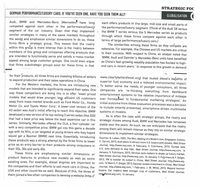
Practical Management Science
6th Edition
ISBN: 9781337406659
Author: WINSTON, Wayne L.
Publisher: Cengage,
expand_more
expand_more
format_list_bulleted
Question
Which elements of the General Environment are significant to the future of the German luxury car industry?

Transcribed Image Text:STRATEGIC FOC
GERMAN PERFORMANCE/LUXURY CARS: IF YOU'VE SEEN ONE, HAVE YOU SEEN THEM ALL?
GLOBALISATION
Audi, BMW and Mercedes-Benz (Mercedes have long
competed against each other in the performance/luxury
segment of the car industry. Given that they implement
similar strategies in many of the same markets throughout
the world and emphasise similar dimensions to do so, these
firms förm a strategic group. This means that the rivalry
within this group is more intense than is the rivalry between
members of this group and companies offering products that
are intended to functionally serve and satisfy a mass-market
appeal among large customer groups. One could even argue
that three substrategic groups exist for these firms in that
each offers products in the large, mid-size and small parts of
the performance/luxury segment. (Think of the Audi S8 versus
the BMW 7 series versus the S Mercedes series as products
through which these firms compete against each other in
terms of large performance/luxury cars.)
The similarities among these firms as they compete are
extensive. For example, the Chinese and US markets are critical
to their success. With respect to China, an analyst noted that
"BMW, Audi and Daimler's Mercedes-Benz units have benefited
as China's fast-growing wealthy population has flocked to high-
end cars in recent years.' In response to this growth in demand
for their products, all three firms are investing billions of dollars
to expand production and their sales operations in China.
models that are intended to significantly expand their sales. One
way these competitors are doing this is to offer 'lower-priced
models that would draw younger, less affluent US customers
away from mass-market brands such as Ford Motor Co., Honda
Motor Co. and Toyota Motor Corp'. A lower-cost version of the
www.clearlybetterdiesel.org} that touted diesel's benefits of
superior fuel economy and a reduced environmental impact.
For the Western markets, the firms are introducing new To better serve the needs of younger consumers, all three
çòmpanies are 're-thinking everything from dashboard
entertainment systems to the relative importance of mileage
over horsepðwer to fundamental marketing strategies'. An
initial outcome from these evaluation processes was a decision
to include smartly presented, smartphone-driven multimedia
A3 sedan was Audi's initial offering to reach this objective. BMW
developed a new version of its top-selling 3 series sedan (the 320)
that had a base price way below the least expensive car in this
series. Similarly, Mercedes offered the CLA, a four-cylinder car
with a very competitive price. BMW got into this game a decade
ago with its Mini, a car targeted at young drivers who they hoped
would get a Beemer (BMW) next time. Essentially, introducing
systems in models.
As is often the case with strategic groups, the rivalry and
strategic moves among Audi, BMW and Mercedes has remained
stable over the years. As such, we can anticipate that the rivalry
among them will remain intense as they rely on similar strategic
dimensions to implement similar strategies.
Sources: B. Laban, 2003, The Mini: Making of a Modern Icon, Singapore: Collins;
C. Carroll, 2013, Audi plans to attract more U.S. buyers with diesels, Wall Street
Journal, http://www.wsj.com, 8 February; V. Fuhrmans, 2013, Europe bets
U.S. auto demand to stay high, Wall Street Journal, http://www.wsj.com, 16
January; V. Fuhrmans, 2013, German auto makers to shake up luxury market,
Wall Street Journal, http://www.wsj.com, 14 January; V. Fuhrmans & F. Geiger,
2013, W to bolster its output in China, Wall Street Journal, http://www.wsj.
com, 14 March; F. Geiger, 2013, Daimler boosts investment in China, Wall Street
Journal, http://www.wsj.com, 1 February; J. W. Whits, 2013, Beyond boomer
buyers: Car makers seek younger crop of customers, Wall Street Journal,
http/www.wsj.com, 16 January.
these products was a strong attempt by the three firms to lower
price as an entry barrier to their products among consumers in
their 20s, 30s and early 40s.
These firms are emphasising similar dimensions or
product features to produce new models as well as some
existing ones. For example, diesel engines are important to
the companies and their efforts to sell more cars in China, the
USA and other countries as well. Because of this, the three of
them joined a few other companies to develop a website (http://
Expert Solution
This question has been solved!
Explore an expertly crafted, step-by-step solution for a thorough understanding of key concepts.
Step by stepSolved in 2 steps

Knowledge Booster
Learn more about
Need a deep-dive on the concept behind this application? Look no further. Learn more about this topic, operations-management and related others by exploring similar questions and additional content below.Similar questions
Recommended textbooks for you
 Practical Management ScienceOperations ManagementISBN:9781337406659Author:WINSTON, Wayne L.Publisher:Cengage,
Practical Management ScienceOperations ManagementISBN:9781337406659Author:WINSTON, Wayne L.Publisher:Cengage, Operations ManagementOperations ManagementISBN:9781259667473Author:William J StevensonPublisher:McGraw-Hill Education
Operations ManagementOperations ManagementISBN:9781259667473Author:William J StevensonPublisher:McGraw-Hill Education Operations and Supply Chain Management (Mcgraw-hi...Operations ManagementISBN:9781259666100Author:F. Robert Jacobs, Richard B ChasePublisher:McGraw-Hill Education
Operations and Supply Chain Management (Mcgraw-hi...Operations ManagementISBN:9781259666100Author:F. Robert Jacobs, Richard B ChasePublisher:McGraw-Hill Education
 Purchasing and Supply Chain ManagementOperations ManagementISBN:9781285869681Author:Robert M. Monczka, Robert B. Handfield, Larry C. Giunipero, James L. PattersonPublisher:Cengage Learning
Purchasing and Supply Chain ManagementOperations ManagementISBN:9781285869681Author:Robert M. Monczka, Robert B. Handfield, Larry C. Giunipero, James L. PattersonPublisher:Cengage Learning Production and Operations Analysis, Seventh Editi...Operations ManagementISBN:9781478623069Author:Steven Nahmias, Tava Lennon OlsenPublisher:Waveland Press, Inc.
Production and Operations Analysis, Seventh Editi...Operations ManagementISBN:9781478623069Author:Steven Nahmias, Tava Lennon OlsenPublisher:Waveland Press, Inc.

Practical Management Science
Operations Management
ISBN:9781337406659
Author:WINSTON, Wayne L.
Publisher:Cengage,

Operations Management
Operations Management
ISBN:9781259667473
Author:William J Stevenson
Publisher:McGraw-Hill Education

Operations and Supply Chain Management (Mcgraw-hi...
Operations Management
ISBN:9781259666100
Author:F. Robert Jacobs, Richard B Chase
Publisher:McGraw-Hill Education


Purchasing and Supply Chain Management
Operations Management
ISBN:9781285869681
Author:Robert M. Monczka, Robert B. Handfield, Larry C. Giunipero, James L. Patterson
Publisher:Cengage Learning

Production and Operations Analysis, Seventh Editi...
Operations Management
ISBN:9781478623069
Author:Steven Nahmias, Tava Lennon Olsen
Publisher:Waveland Press, Inc.